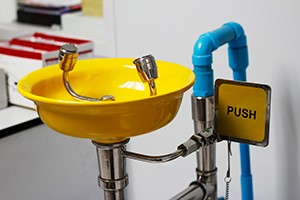6 Questions to Help You Maintain and Inspect Your Eyewash Station

Our eyesight is invaluable, so it’s crucial to protect it, including on the job. In workplaces where employees are exposed to corrosive or caustic materials, eye injuries blind thousands annually. The Occupational Safety and Health Administration (OSHA) mandates that eyewash stations be available where injurious chemicals are present. Installing an eyewash station isn’t enough, though; it requires regular inspections to ensure that it’s functioning properly and close enough to handle any liquid splash incident.
The questions below, based on Z358.1 eyewash unit standards from the American National Standards Institute (ANSI), will help you better inspect and maintain your eyewash station.
1. Has the station been inspected or tested recently?
- Eyewash units should be activated at least once weekly (ANSI Z358.1, Section 5.5.2)
- They should be inspected annually for compliance with ANSI Z358.1 standards (Section 5.5.5.)
2. Is the eyewash station located reasonably near an identified hazard?
- An eyewash safety station must be located within 10 seconds, or approximately 55 feet, from a hazard, and on the same plane as that hazard (Section 5.4.2; B5)
- If a hazard includes caustics or strong acids, the station should be located next to it (Section 5.4.2; B5)
3. Is the eyewash station identifiable and accessible?
- There must be an unobstructed travel path to the station (Section 5.4.2; B5)
- A station must be in a well-lit area and the unit must have a highly visible sign (Section 5.4.3)
4. Does the station have proper water pressure and flow?
- An eyewash unit must deliver at least 0.4 gallons of water per minute for 15 minutes (Sections 5.1.6, 5.4.5)
- Eye/face wash stations must deliver 3 gallons of water per minute; this is the primary difference between these units and regular eyewash stations
- The water flow is 33-53” above the floor and at least 6” from a wall or other obstruction (Section 5.4.4)
5. Does the unit work properly?
- The supply valve activates in one second or less (Sections 5.1.4, 5.2)
- The supply valve is a hands-free, stay-open valve that only switches off when intentionally closed by the operator (Sections 5.1.4, 5.2)
- An eyewash safety station must wash both eyes simultaneously (Section 5.1.8)
- The water flow must allow the user to hold their eyes open without exceeding 8” above the spray heads (Section 5.1.8)
6. Is the station safe to use, with good quality water?
- All nozzles and spray heads have nozzle caps to prevent squirting airborne contaminants like dust or dirt (Section 5.1.3)
- Nozzle caps come off with water flow (Section 5.1.3)
When inspecting an eyewash station on a regular basis, it helps to have a checklist of questions that any employee can use to spot immediate signs of disrepair:
- Does the water look clear?
- Are all jets and valves working properly?
- Are there any leaks?
- Is there a bucket located under the eyewash unit for water runoff?
- Is the station well-lit, properly marked, and accessible without obstructions?
Portable Eyewash Stations
ANSI Z358.1 standards apply to portable eyewash stations as well, making no distinction between these and permanent installations in terms of availability, required response times, and most procedures. A portable station should still be accessible within 10 seconds and capable of providing 15 minutes of tepid water flow.



